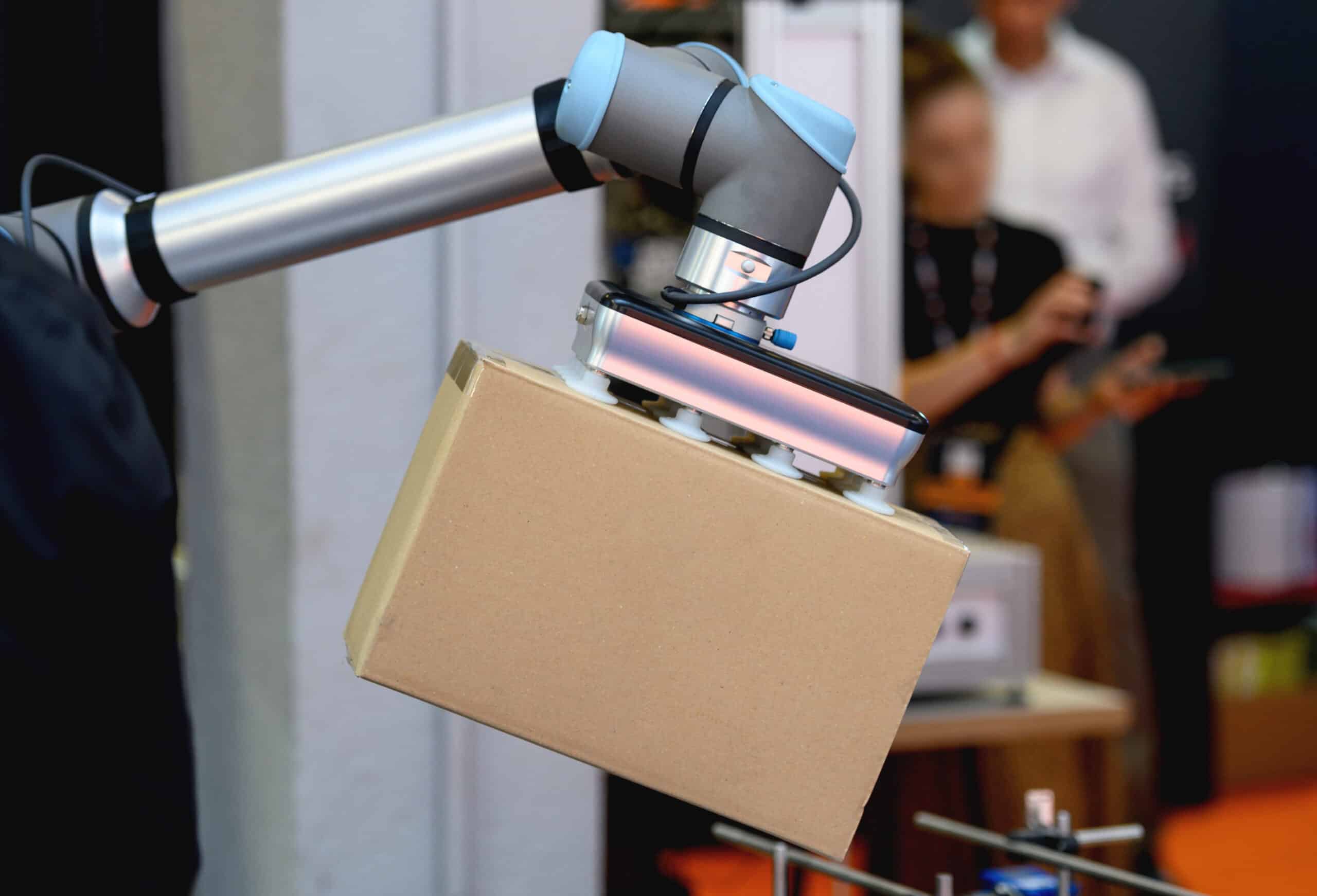
In the context of this blog post, given the site you’ve landed on, what we should really be discussing is whether AI is taking over temp jobs.
Temp jobs can take various forms, including contract positions, freelance work, or agency placements, offering flexibility to both employers and employees. The often quick turnaround of temp jobs gives workers exposure to different industries (in the case of Indeed Flex, the hospitality, retail, industrial,and facilities management sectors), and the potential for future permanent employment.
Whatever the industry though, the growing influence of AI in the job market is reshaping the nature of work across various sectors. AI technologies are increasingly being integrated into business processes, leading to greater efficiency, productivity, and innovation.
Typical examples of AI include machine learning and automation.
Machine learning is, effectively, teaching computers to learn from examples. Instead of giving them specific instructions for every task, we show them lots of examples and let them figure out patterns on their own. It’s very similar to how we learn – by seeing and doing things repeatedly. Once the computer learns from these examples, it can apply that knowledge to new situations and make decisions or predictions without being programmed for each individual scenario.
Automation involves getting computers to do things on their own without people telling them exactly what to do each time. It’s like teaching a computer to follow a set of instructions so that it can perform tasks by itself. AI automation helps machines handle tasks automatically, making things faster and more efficient. This technology is used in different areas, like making cars or answering questions online.
Then there’s the AI we’ve all heard about, such as Chat GPT, which can help to write all manner of things; from poems, to comedy scripts, to entire manifestos. In fact, it is, in part, responsible for you being over 350 words into this blog post.
There are two sides to every coin though. AI has the potential to create new job opportunities in emerging fields like data science and (obviously) AI development, as well as more traditional fields, like healthcare and customer service. However, the one particular thought about machines taking over jobs persists, with serious concerns over the displacement of certain traditional roles. Routine and repetitive tasks are more open to automation, impacting jobs in sectors like manufacturing, administration, and even certain elements of accounting and bookkeeping.
Somewhat ironically, the widespread adoption of AI is driving the demand for skills related to AI itself – its implementation and maintenance, as well as ethical considerations.
In this post, we’ll consider the growth of AI, industries in which it’s most prevalent, the common misconceptions surrounding it, how humans and AI can coexist, the benefits of AI integration in temp work, potential drawbacks and challenges, and steps you can take to thrive in an AI-driven landscape.
The rise of artificial intelligence
AI and its huge growth
AI, as a broad term, refers to the development of computer systems that can perform tasks that typically require human intelligence. These tasks include learning, reasoning, problem-solving, perception, speech recognition, language understanding, and design. AI systems are designed to mimic how our brain functions, allowing them to analyse data, adapt to changing inputs, and perform tasks with a degree of autonomy – effectively working ‘hands free’.
Its growth in recent years – particularly the last two or so – has been exponential. Programs like Chat GPT, Bard, and Bing AI have all exploded onto the scene.
But what’s fuelled this intense growth?
- Advancements in machine learning: Machine learning, as mentioned in the intro to the post, has seen tremendous progress. Algorithms (a set of instructions that tells a computer how to perform a task) can now learn from data and improve performance over time without being explicitly programmed.
- Increased computing power: The availability of powerful hardware, including Graphics Processing Units (GPUs) and specialised AI computer chips, has accelerated the training and execution of complex AI models.
- Big data: The rapid increase in the availability of massive datasets within organisations has provided the raw material for training sophisticated AI models. These huge bundles of data allow AI systems to recognise patterns and make more accurate predictions.
- Cloud computing: Access to cloud computing resources has made AI available to a much wider audience — whether to individuals simply uploading their photos, or to companies and researchers looking to leverage cloud platforms to scale their AI applications.
- Open source contributions: Many AI tools are open source, meaning that almost anyone can work on them, fostering collaboration and knowledge-sharing within the global AI community. This, in turn, has accelerated the development of AI programs
- Integration into multiple industries: AI is increasingly being integrated into various industries, including healthcare, finance, manufacturing, retail, marketing, education, and many more. Applications range from medical diagnosis and financial fraud detection to intelligent tutoring systems, and autonomous vehicles.
- Rapid research and development: The academic and corporate sectors are investing heavily in AI research and development, leading to breakthroughs in natural language processing, computer vision, reinforcement learning, and other AI subfields.
- Government initiatives: Governments around the world are recognising the strategic importance of AI and are investing in research, education, and policies to promote its responsible development.
So, there’s no doubt about it, AI is here to stay and its use will only continue to grow and expand across nearly every industry imaginable, so it’s best to get comfortable with the idea of living with it.
However, as it continues to grow there are ethical considerations to take into account, surrounding transparency, accuracy of information, and the responsible deployment of various technologies, particularly when referring to military scenarios.
AI will, though, have a big part to play in shaping various aspects of society and industry
Industries where AI is prevalent
AI is being used across pretty much every industry, so even if you’re juggling multiple jobs, it’s most likely you’ll come across it in some form or fashion. This, again, raises the question as to whether robots are replacing jobs. It is transforming various sectors by enhancing efficiency, automation, analysis, and decision-making. Some of the industries where AI is making significant contributions include:
- Healthcare: AI is employed for medical imaging analysis, drug discovery, personalised medicine plans, and patient management, to name but a few areas it’s involved in
- Finance: AI is used for fraud detection, trading, credit scoring, customer service chatbots, and for providing personalised financial advice.
- Automotive: Scarily, some might say, AI already powers self-driving cars. It also enhances vehicle safety features, and improves manufacturing processes in the industry.
- Energy: In the energy sector, AI is applied to optimise the energy grid, and to develop smart grids for efficient energy distribution.
- Agriculture: AI has become essential within agriculture, being used for precision farming, crop monitoring, pest control, and yield prediction – all vital to farmers.
- Entertainment: AI powers content recommendations on streaming platforms, such as Netflix and Amazon Prime. It also powers virtual reality experiences, and personalised gaming experiences.
- Human Resources: In some organisations, AI is used for CV screening, candidate matching, and employee engagement analysis. At Indeed Flex, you’ll be pleased to know we don’t use AI to screen you – you’ll be interviewed by a real person, via video link, after filling in a quick profile.
- Insurance: AI helps when it comes to risk assessment, fraud detection, claims processing, and personalised insurance offerings – tailored to each individual customer.
- Travel and hospitality: In this industry, AI is used for personalised travel recommendations, chatbots for customer support, and demand forecasting in the hospitality industry.
Now consider that the list above is nowhere near complete – this is just a sampling of the industries that AI has been adopted by, in all its different guises.
The chances are, it’s already being used in your industry, you just don’t know about it. But don’t worry, you’re safe for now from AI taking over jobs.
AI and job automation: myths vs. reality
Common misconceptions about AI taking our jobs
Yes, again, it’s widely reported that robots are taking over jobs, but this is quite wide of the mark – certainly at the moment. While it’s better to accept AI and learn to work with it, that doesn’t mean that your employment is under threat.
Here, we look to debunk a few myths about AI – a few rumours doing the rounds:

Myth #1: AI will replace all jobs.
The truth: While AI may automate certain tasks, it’s unlikely to replace all jobs – some jobs are simply too highly skilled, such as surgical procedures, and some involve manual dexterity AI just doesn’t have, like constructing a building. Instead, it’s more likely to transform the nature of work, with some jobs being elevated or complemented by AI technologies.
Myth #2: AI will lead to mass unemployment.
The truth: Instead of AI taking over jobs, it may be quite the opposite, in fact. AI has the potential to create new job opportunities in emerging fields related to AI development, maintenance, and oversight.
Myth #3: All jobs are equally susceptible to automation.
The truth: AI is more likely to automate routine, repetitive tasks, while jobs requiring creativity, emotional intelligence, complex problem-solving, skilled professionals (carpenters, plumbers, electricians and the like), human interaction, and ethical decision-making are less easily automated. Many roles involve a combination of technical and soft skills that AI currently struggles to replicate.
Myth #4: AI implementation is an all-or-nothing scenario.
The truth: AI adoption is a gradual process, so even if robots are replacing our jobs, they’re certainly not doing so overnight, and organisations can choose how extensively they integrate AI into their operations. Many industries have been implementing AI technologies bit by bit, seeing how they cope with specific tasks or processes rather than completely overhauling all systems and processes.
Myth #5: AI will only benefit large corporations.
The truth: Small and medium-sized enterprises (SMEs) can also benefit from AI technologies. Cloud-based AI services and free, open-source tools make AI more accessible, allowing SMEs to implement AI solutions without making massive investments.
Myth #6: AI will replace skilled professionals.
The truth: Skilled professionals, especially those with expertise in developing, managing, and overseeing AI systems, are likely to be in demand. And those with traditional skills, such as carpentry, plumbing, stonemasonry, artistic skills, cooking and baking are likely to be more in demand than ever.
Myth #7: The speed of AI adoption will lead to a job crisis.
The truth: While the uptake of AI has been somewhat rapid, it will take time for workforces to adapt, as individuals are reskilled and upskilled in this new way of working. In the meantime, proactive measures can be put in place to lessen potential negative impacts on employment.
Working in harmony: the coexistence of AI and human workers
Rather than robots taking over jobs, it has been shown that AI and human workers can happily coexist in a variety of workplaces, with each complementing the other’s skills and strengths. For the humans, this frees up time that would have been spent on repetitive, menial, or mundane tasks, leaving more time available for more complex tasks – those which require more focus.
Here are some examples of how AI and human workers are working together effectively:
- Healthcare: AI is being used to assist doctors in diagnosing diseases, analysing medical images, and developing personalised treatment plans. For example, AI-powered systems can analyse patient data and medical images, to identify patterns and potential abnormalities that human doctors might miss.
- Manufacturing: Human workers are finding they have more time to focus on more complex tasks, such as design, problem-solving, and customer service, while AI is being used to automate tasks such as quality control, predictive maintenance, and supply chain optimisation.
- Finance: AI is being used to detect fraud, analyse market trends, and manage investment portfolios, allowing human financial analysts to make more informed decisions and identify potential risks.
- Customer service: In sectors such as banking, insurance, and online retail, AI-powered chatbots are being used to handle routine customer enquiries, freeing up human customer service representatives to handle more complex issues that require empathy, understanding, and a slightly more tailored approach.
- Education: AI is being used to personalise learning experiences, particularly to students who might need additional support. This technology helps teachers differentiate their teaching and provide more individual support for each student.
- Law: In the legal profession, AI is being used to research legal precedents, identify potentially relevant cases, and draft legal documents. This technology helps lawyers to be more efficient and effective in their work, and deal with more complex legal issues on behalf of their clients.
- Journalism: AI is being used to generate news articles, translate languages, and identify potential bias in reporting. This technology helps journalists to be more productive, delve deeper into key stories, and reach a wider audience.
- Retail: In retail, AI is helping to push the economy forwards – being used to personalise product recommendations, optimise store layouts, and manage inventory levels.
In each of these examples, AI is not replacing human workers; it’s working with them to push their thinking forwards and free up their time to work on more complex aspects of their roles. As AI continues to develop, we will undoubtedly see even more examples of how AI and human workers can work together to achieve better outcomes for all.
Impact of AI on temporary jobs
Analysis of AI’s influence on temp jobs
When it comes to robots taking over temporary jobs, AI is expected to have a mixed impact on the demand for temp jobs in the UK. On the one hand, AI automation is likely to displace some temp workers in routine and repetitive tasks, such as data entry, customer service (particularly with the rise of chatbots), and manufacturing processes. An obvious example is the introduction of self-checkout tills in supermarkets, which has already led to job losses for cashiers.
On the other hand, AI is also creating new opportunities for temp workers in fields such as AI engineering, data science, and cybersecurity. These fields require specialised skills that are not yet widely available, making temp workers with these skills highly sought after. In addition to this, AI is transforming the nature of many existing temp jobs, requiring workers to adapt their skills and responsibilities. For instance, temp workers in manufacturing may need to learn how to operate and maintain AI-powered machinery or retail workers may have to help with the design of AI-inspired store layouts
In short, temp workers will most likely need to develop new skills to stay competitive. These skills include data analysis, machine learning, AI ethics, and problem-solving.
But it’s worth remembering that, regardless of the changes that lie ahead, there are still many benefits to working a temporary job.
The impact of AI on temp worker wages and working conditions
The impact of AI and job automation on temp worker wages and working conditions is likely to be mixed. On the one hand, AI could lead to increased competition for temp jobs, which could lead to a downward spiral in terms of wages. It could also make it easier for employers to monitor and control temp workers, which could lead to more demanding work environments.
However, on the flip side to this, AI could also lead to increased demand for temp workers with specialised skills, which could push wages up. It could also make temp jobs more interesting and challenging, which could improve working conditions.
The overall impact of AI on temp work in the UK is likely to be positive. AI will create new opportunities for temp workers, transform the nature of temp jobs, and require temp workers to develop new skills. However, AI will, without doubt, also displace some temp workers in routine and repetitive tasks. As a result, the net impact of AI on temp work is likely to be a slight increase in the number of temp jobs available.
The Future of Temp Work with AI
Predictions for the future of temp work in the world of AI
So, while we’ve established that AI isnt taking over all jobs, temp or otherwise, just yet, we can make some predictions for the future of temp work considering AI advancements, based on current trends:
Increased demand for temp workers with specialised skills: As mentioned, AI is automating many routine and repetitive tasks, creating a need for temp workers with specialised skills to manage and oversee AI-powered systems, develop AI applications, and adapt to the changing demands of the AI-driven economy.
Greater flexibility and agility: AI tools can match temp workers with suitable roles more efficiently and quickly. In fact, Indeed Flex already uses smart-matching technology to help jobseekers find the right jobs quicker. All of this will enable businesses to adapt to fluctuating workloads and market demands with greater flexibility.
Shift towards project-based temp work: As AI automates more day-to-day tasks, the focus of temp work is likely to shift towards project-based assignments, where temp workers are hired for specific projects with clear outcomes and deadlines, rather than being brought in as a short-term fix. This could lead to a more project-based and less traditional work culture for temp workers.
Rise of AI-powered talent platforms: AI-powered talent platforms are emerging to connect businesses with temp workers with the skills and experience they need. These platforms can analyse and match CVs, assess skills and relevant experience, and provide the analytics to help businesses find the right temp workers for their specific needs.
Greater emphasis on upskilling and reskilling: As AI continues to evolve, temp workers will need to continuously upskill and reskill to stay relevant and competitive in the job market. AI-driven learning tools and platforms will provide temp workers with opportunities to learn new skills and adapt to changing job requirements.
Emphasis on soft skills and human interaction: While AI can automate many tasks, it still lacks the ability to provide empathy, creativity, and human connection.
Regulation and ethical considerations: Governments and industry bodies will need to establish clear guidelines and regulations for the use of AI in the workplace, ensuring that AI is used ethically and does not create unfair or discriminatory practices.
Overall, AI is expected to have a significant impact on the future of temp work, creating new opportunities, transforming job roles, and requiring temp workers to develop new skills for this new world we’re now entering. It will become increasingly more important to focus on upskilling, flexibility, and the human aspects of work to ensure that temp workers benefit from AI advancements and are not displaced by AI.
How workers can thrive in an AI-driven landscape
Just because AI isn’t taking over jobs just yet, doesn’t mean you should be complacent. You’ll need to work with AI, rather than against it. In future-proofing yourself, you can limit the impact of AI on yourself as a temporary worker.
Here are just a few tips as to what you can do:
Upskill and reskill: Look to continuously develop and refine your skills relevant to the AI-driven economy. This includes learning about data analysis, machine learning, AI ethics, and other areas where AI is transforming the workplace.
Enhance soft skills: AI can do many things, but, devoid of arms and legs and an actual brain, it falls short when it comes to softs skills. These are things such as communication, problem-solving, time management, adaptability, creativity, leadership, teamwork. Focus on developing these skills and you’ll remain relevant in the workplace.
Stay informed about AI trends: Keep up to date with the latest developments in AI technology and how it’s being used in various industries, particularly the one you happen to work in. This will help you to understand the potential impact of AI on your job and prepare for any upcoming changes.
Become an AI advocate: Don’t fight it – shout about it! Share your knowledge and understanding of AI with colleagues and employers. This will ultimately lead to a more collaborative and informed approach to AI adoption in the workplace.
Seek out opportunities to learn: Take advantage of training programmes, workshops or webinars, and online resources, to learn about AI and enhance your skill set. Many organisations offer such programmes at a subsidised rate, or entirely free.
Network with other professionals: Connect with colleagues, managers, industry experts, and professionals in AI fields to exchange ideas, learn from their experiences, and stay informed about emerging trends.
Be open to new opportunities: Be willing to explore new career paths, roles, and industries that are emerging due to advancements in AI. The AI-driven economy will create new opportunities for those who are open to change.
Stay positive and optimistic: AI is not a threat to jobs but rather a force for good, in creating change and new opportunities. Embrace the opportunities that AI presents and view it as a tool to enhance your skills and career prospects, rather than something to be afraid of.
Is AI taking over jobs: in conclusion
The short answer to this is no – not yet. It may be taking over some jobs, such as those which require data entry and certain customer service roles, but it’s far from the complete package. What it lacks is human understanding, warmth, empathy, the years of experience an individual might have and soft skills, such as communication, leadership, time management, and intuition.
Having said that, there are many industries where humans are learning to work in conjunction with AI, including healthcare, finance, manufacturing, retail, and journalism.
It’s also opening up new roles, such as those which involve overseeing AI-powered systems, developing AI applications, and analysing the output of AI programs.
AI is going nowhere, its prevalence and influence in the workplace is only set to grow. So, it’s better to work with it than work against it, and look to the future – how you could potentially upskill or reskill and stay one step ahead of the game.
Download the Indeed Flex app today and benefit from a world of temporary work opportunities across all different industries and employers.








